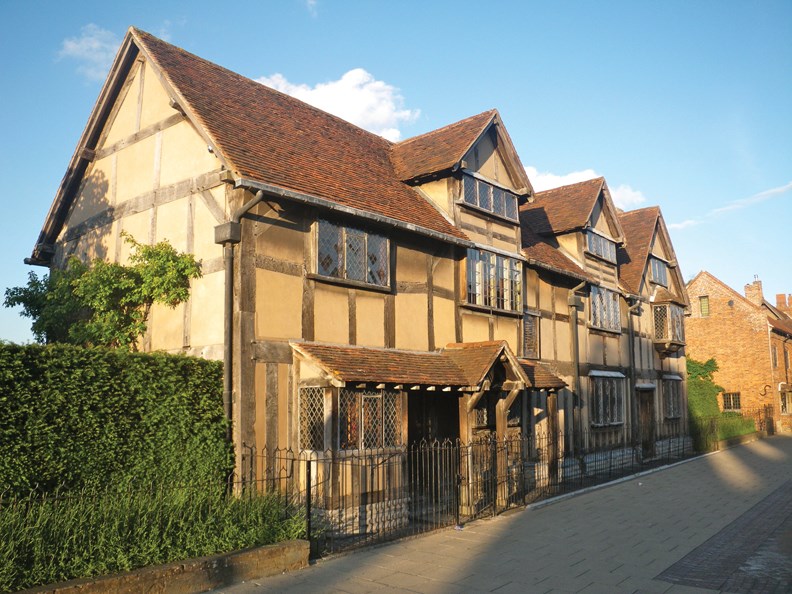A guided walk acquaints us with William Shakespeare’s charming hometown.
“When Shakespeare was born, only 1,500 people lived in Stratford-Upon-Avon,” guide David explains. “Then, guildhalls, small straw-thatched houses with open pit fires and 50 taverns crowded along foul, muddy streets.” Most of the old town burned down three times; Harvard House is one of the era’s surviving half-timbered buildings.
“Stately Town Hall replaced Market Hall, which exploded while storing gunpowder in the 1640s,” David recounts. “Famed 18th-century actor David Garrick donated Shakespeare’s statue in its niche.” Just opposite, Old Bank displays a mosaic likeness of Shakespeare and frieze of Shylock above its entrance.
A leisurely stroll away, Shakespeare’s birthplace has long attracted visitors. Inside his family’s 16th-century home, patterned linen wallpaper and sturdy oak furniture reflect their comfortable, middle-class life. His prosperous father made fine leather gloves in the ground floor workshop, still set up for work.
In the nursery upstairs, a bonneted docent recounts, “Born in this bed, Shakespeare later slept here with two brothers; a third slept in that cradle. Two sisters shared the adjoining room.” We visualize them playing together on the oak floor. “And after marrying, William and Anne lived in this home five more years,” she adds.
In another room, signatures of Dickens, Carlyle, Scott, Twain and others inspired by the Bard are etched on a windowpane. Seated amid the gardens, we watch costumed actors re-enact favorite Shakespearean characters.
Heading along Chapel Street, David points out the foundations of Shakespeare’s grand house. “As a successful playwright, Shakespeare bought New Place, the town’s second largest. He died there after celebrating his 52nd birthday,” David says. Restored gardens at New Place will reopen in April 2016 to commemorate the 400th anniversary of his death.
At the still-used grammar school nearby, young Will studied Latin, rhetoric, classical theatre and history. He left early at 13 when family fortunes reversed. Beyond stands Hall’s Croft, elegant home of daughter Susanna and eminent physician, John Hall. Walled gardens still enclose the beds of medicinal herbs.
An avenue of lime trees leads us to 13th-century Holy Trinity Church. Inside, we see Will’s marble baptismal font and parish register listing his 1564 baptism and 1616 burial. His bust sits on a shelf above the chancel where he, Anne, Susanna, Dr. Hall and Nash rest. Outside, David dramatically concludes our walk by reciting Quoting Shakespeare, a poem celebrating the Bard’s contributions to our language.
A little further afield, a two-kilometre pathway leads us to Anne Hathaway’s cottage in Shottery. Lush Elizabethan gardens surround the family’s thatched farmhouse. We visualize Anne watching for Will from latticed windows. Inside, antique furnishings include the settle where he wooed her. Upstairs, the Hathaways’ rare carved bed boasts a typical canopy, protecting sleepers from varmints falling from the thatch.
A hop-on-hop-off bus carries us to Wilmcote, five kilometres away. Shakespeare’s grandmother’s 1570s home has long been the main attraction at Mary Arden’s Farm, a working Tudor farm. Activity boards encourage us to see rare domestic animal breeds, practise archery and simulate chores young William experienced.
Along the Avon River at Bancroft Gardens, we contemplate Gower’s memorial to Shakespeare’s genius. The Bard sits on a pedestal. Below, Hamlet, Prince Hal, Lady Macbeth and Falstaff represent his brilliant insights into philosophy, history, tragedy and comedy.


